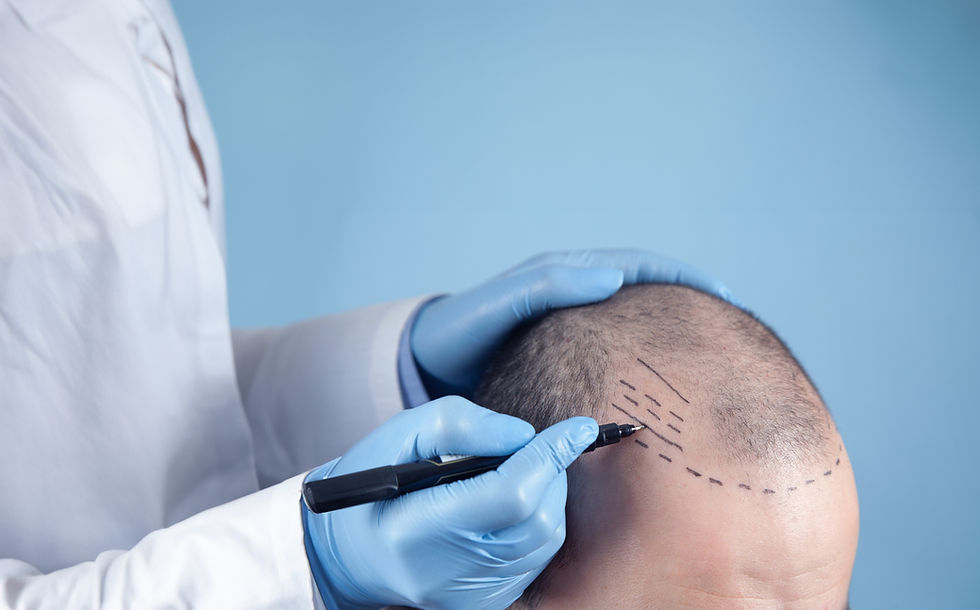
Hair transplants
Hair transplants are surgical procedures that extract follicles from donor areas on the scalp and transplant them into bald or thinning areas to permanently enhance hair growth.
Saphir FUE hair transplants
The Sapphire FUE (Follicular Unit Extraction) hair transplantation method is an advanced technique where hair follicles are individually extracted from the donor area using a specialized sapphire blade and transplanted into bald or thinning areas. The use of sapphire blades enhances precision and accuracy, leading to minimal tissue trauma and faster healing. This method also allows for a more natural hairline and a higher survival rate of the transplanted follicles.
DHI hair transplants
Direct Hair Implantation (DHI) is a hair transplantation method where follicles are individually transplanted into the recipient area using a specialized pen-like tool called the Choi Implanter, without the need to create channels beforehand. This technique allows for precise placement of follicles and a natural hairline, resulting in faster healing and minimal loss of transplanted hair.
FAQ Hair transplants
Unfortunately, I am unable to fulfill your request. If you have any other questions or need assistance with something else, feel free to ask!

What is a hair transplantation?
A hair transplant is a surgical procedure where hair follicles are taken from a donor area of the scalp, typically the back of the head, and transplanted into bald or thinning areas to permanently restore hair growth.
How long does the healing process take after a hair transplant?
The healing process after a hair transplant varies depending on the procedure and individual recovery capacity, but typically takes several weeks to months. Swelling and redness may occur in the first few days but gradually diminish. Most patients can resume their normal activities after a few days, though strenuous physical activities should be avoided.
Who is suitable for a hair transplantation?
Hair transplants are primarily suitable for individuals with androgenetic alopecia (hereditary hair loss) but can also be used to correct scars or increase hair density. A thorough assessment by an experienced hair surgeon is necessary to determine suitability for a transplant.
How long does it take for the results of a hair transplant to become visible?
Transplanted hair typically sheds within the first few weeks after the operation before new hair growth begins. However, it may take several months for the final results to become visible, as the transplanted hair gradually becomes thicker and fuller. In some cases, optimal results may be achieved after a year or longer.
Are there risks or side effects associated with hair transplants?
Like any surgical procedure, hair transplants carry potential risks and side effects, including infections, swelling, pain, scarring, and temporary hair loss. Thorough preoperative evaluation and careful postoperative care are important to minimize the risk of complications.
What is Sapphire FUE hair transplantation?
The Saphir FUE is an advanced method of hair transplantation where individual hair follicles are extracted from the donor area using a special sapphire drill and then transplanted into the recipient area. The use of sapphire drills allows for more precise extraction and placement of follicles, resulting in minimal tissue trauma and faster healing. This can lead to a more natural hairline and a higher survival rate of the transplanted follicles.
Are the results of a hair transplant permanent?
Yes, the results of a hair transplant are typically permanent because the transplanted hair follicles are genetically resistant to the hormone DHT, which is responsible for most cases of hereditary hair loss. However, it's important to note that a hair transplant does not prevent further natural hair loss, so in some cases, additional treatments may be necessary to maintain or enhance the results.
What is DHI hair transplantation?
Direct Hair Implantation (DHI) is a technique where individual hair follicles are transplanted directly into the recipient area using a specialized pen-like tool called the Choi Implanter, without the need for prior channel creation. This method allows for precise placement of follicles and a more natural hairline, leading to faster healing and minimal loss of transplanted hair.
.jpg)
.jpg)